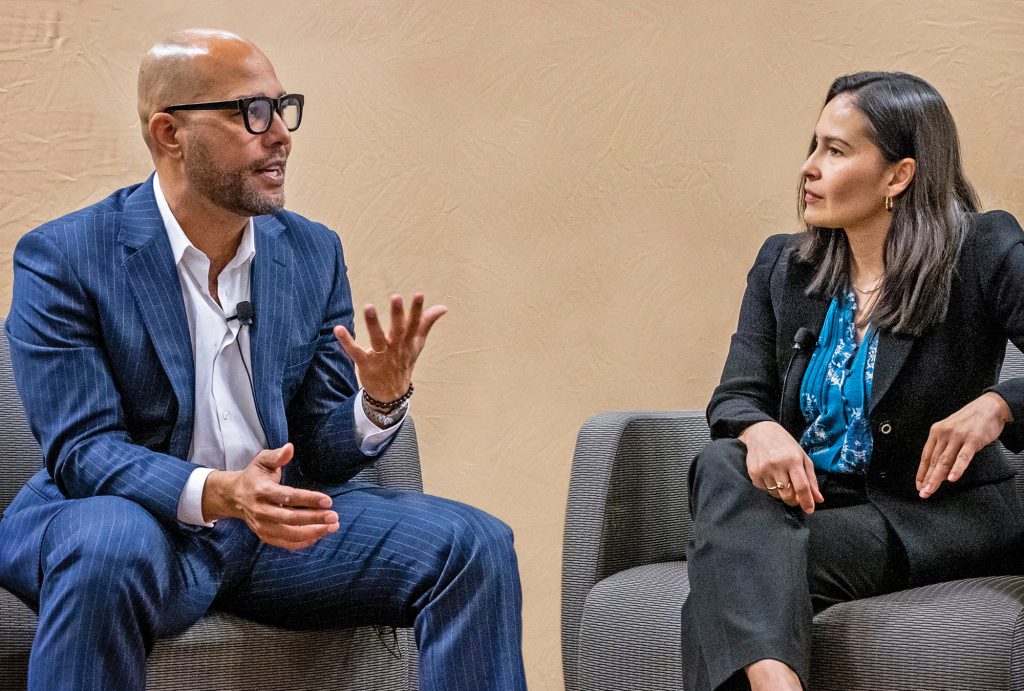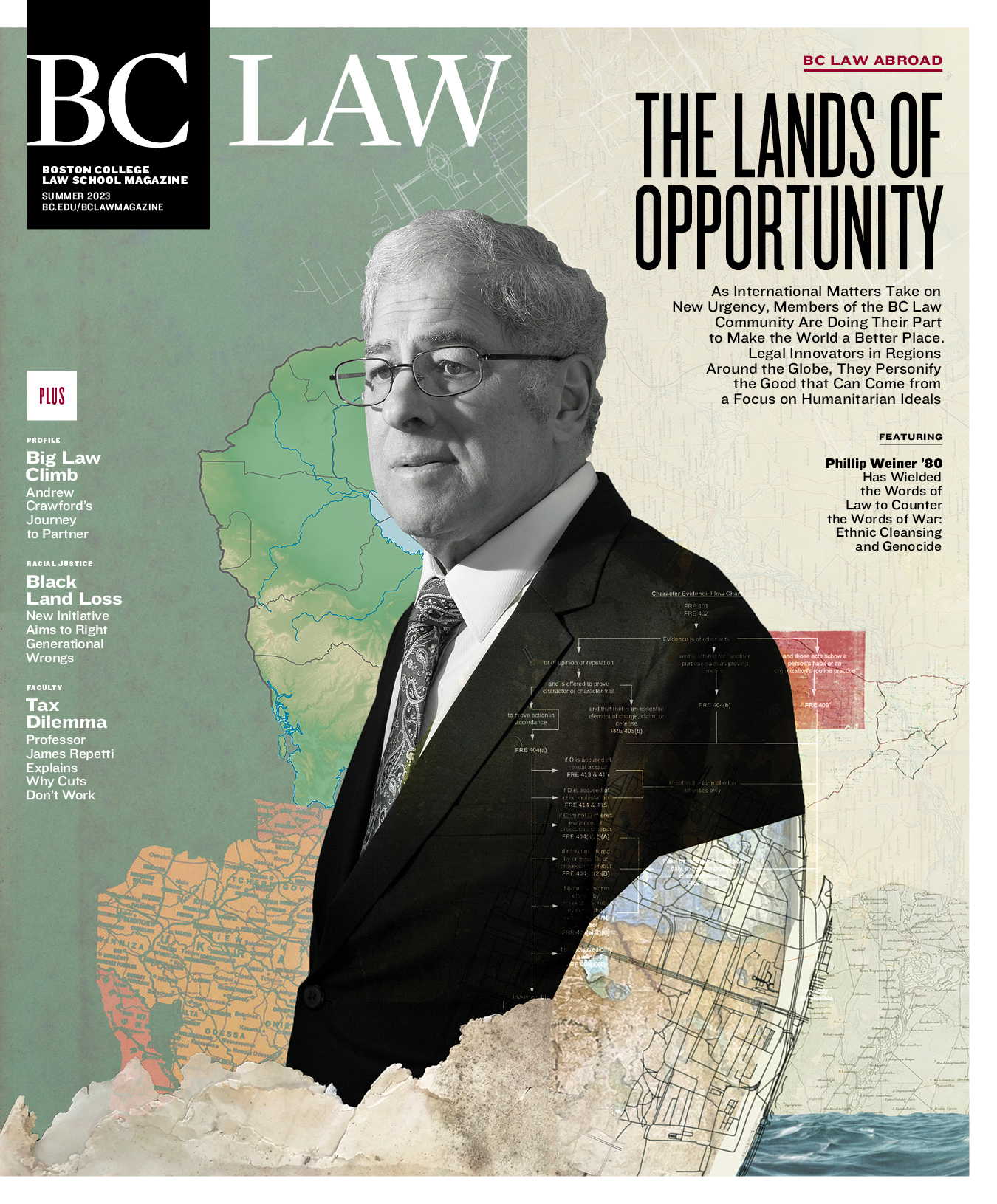While an attorney at Sidley Austin, George C. Fatheree III orchestrated a precedent-setting transaction in California that returned $20 million to descendants of the Black family who owned Bruce’s Beach, a popular water-front property wrongly taken by the city of Manhattan Beach nearly a century ago. He also advises clients in complex commercial real estate transactions and is a leading advocate on legal matters involving Black empowerment and culture. As keynoter of the Land Loss, Reparations, and Housing Policy Conference at BC Law in March, Fatheree had a fireside chat with Dean Odette Lienau about the pivotal reparations case.
OL: Thank you for joining us! Who were the Bruces and what happened at Bruce’s Beach?
GF: First, I want to say thank you because I’ve learned from doing this work that the real change starts in rooms like these with conversations that change the narrative.
Charles and Willa Bruce were an African American couple who, in the early 1900s, as part of the Second Great Migration, moved from the DC area and settled in Los Angeles County. A train ran from downtown LA out to what is today the city of Manhattan Beach, where there was a skating rink pavilion that did not enforce segregation, so Blacks would go there. When Willa saw that, she had the idea to start a business that would attract and cater to Black Angelinos. In 1912, she bought a beachfront parcel, started modestly with a sandwich and soda shack, and within eight years had acquired enough money to buy the adjacent lot and erect a two-story building with a parlor, dining room, and changing rooms for the beach. African Americans came from all of Southern California and as far away as San Francisco and St. Louis.
OL: Not everyone was happy about Willa’s success. Can you explain?
GF: The business was so popular with the Black community that other Black people moved to Manhattan Beach and built homes to be close to Bruce’s Beach. But when I went back and read the local newspapers, I saw concerns from the white citizens about the “Negro invasion” that threatened their way of life. One neighbor to Bruce’s Beach built a wood fence that forced beachgoers to walk a half a mile to get to the water. Others put up no parking signs or let the air out of tires. A Black homeowner woke up at 2:30 one morning to a cross burning in their front yard.
OL: How did things come to a head in the mid-1920s?
GF: A local real estate agent hatched a scheme to take the property from the Bruces by eminent domain on the pretense that the city needed a park. Maps from that time show that the area around Bruce’s Beach was mostly all sand—nothing there except the Bruce’s brick building, some unimproved parcels behind it owned by white families, and, up about two blocks, five Black-owned homes. The city drew the box to take the Bruces’ property, and every piece owned by a Black family, but not the white people’s land.
The Bruces hired an attorney to fight the taking but lost and surrendered the property in 1924. Charles and Willa Bruce died in poverty.
“A local real estate agent hatched a scheme to take the property from the Bruces by eminent domain on the pretence that the city needed a park.”
George C. Fatheree III, who won $20 million in restitution for family descendants nearly 100 years later
OL: Jumping ahead nearly 100 years, what happened?
GF: I had helped with the preservation of an archive of 4.5 million photos from Ebony and Jet magazines chronicling nine decades of Black American history that was threatened with disbursement at a bankruptcy auction. Soon after, an LA Times reporter reached out to me with an article about Bruce’s Beach. She wondered if I’d be interested in looking into it. I was. My firm spent four months trying to figure out if there was litigation that could be brought. We ended up with some creative ideas, but the last thing I wanted to do was reach out to the Bruce family and get their hopes up about something I wasn’t fully confident I could deliver on.
Soon after, in May 2020, we all watched George Floyd be murdered. In the aftermath, there was a kind of reawakening on issues affecting Black Americans. When a woman on the County of Los Angeles Board of Supervisors heard the story of Bruce’s Beach, by then owned by the county, she decided to see if there were a way to give it back. When I heard that, I said, ‘Hallelujah, praise Jesus, thank God!’
Figuring that there were going to be people trying to stop this and that it had to be done exactly right, I decided, ‘I’ve got to do this.’
OL: It must have been challenging. What was the hardest part?
GF: As attorneys, we rely on precedent, but in this situation the biggest challenge was not having a playbook. So, what our team of lawyers did—and much of this during COVID—was spend a lot of time just thinking about how we would handle such a case. In the end, I did not bring a lawsuit. I negotiated the property transfer back to the Bruces.
When people hear that they think, ‘Oh, that must have been easier than a lawsuit where you’ve got a judge to tell the other side they’ve got to do this and that.’ I didn’t have that. The hard part was getting the county to do this in a way that made sense. I encouraged the county to follow a process that could be replicated, a process by which heirs—in this initial instance, my clients, the Bruces—could participate by submitting birth certificates and other records. Time was my enemy; the more time that went by, the more risk there was to the process.
Still, we succeeded. Over the span of two years, two law firms, and a couple dozen attorneys, we logged over a million dollars in pro bono legal fees. In 2022—for the first time in our country’s history—the government returned property to Black people that had been taken from them.
What haunts me is the immeasurable magnitude of what the Bruce family lost. For some reason, I started researching Conrad Hilton Sr., who founded the Hilton Hotel Corporation at the same exact time that Willa Bruce started her operation. Fast forward: The Hilton Corporation has a nearly $40 billion dollar market cap. Seven Hilton heirs are on the Forbes 400 list of richest Americans.
Then I think about the Bruces dying in poverty. I think not only about the wealth for the Bruce family but about the people they would have employed and the wealth that that would have created. I think about Black families who would have visited the resort and been inspired to be entrepreneurs. I think about the philanthropic causes and elected officials that the Bruces would have supported.
Then I take the Bruce example and I multiply it by the thousands, tens of thousands, hundreds of thousands lost. We will need many more than my one model to fix this wealth gap.



